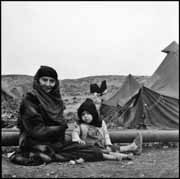
Brandon Judell
The Forgotten Refugees
 |
| "The Forgotten Refugees" |
The United Nations has passed dozens of resolutions over the years attending to the rights of the Palestinian refugees, but none, whatsoever, dealing with the Jewish refugees from the Arabic countries.
The who?
The nearly million people who were driven from their homes by threats of disenfranchisement, imprisonment, torture, rape, and death.
Please note that in 1944 there were 265,000 Jews in Morocco; in 2004, 5000. In Tunisa fifty years ago, the Jews numbered 105,000. Now, 5000. In Algeria during the same period, the population ebbed from 144,000 to 80. And so forth.
Sabri Jiryis, a lawyer and member of the Palestinian National Council, a gentleman one would not ordinarily think would be openly defending Jews, is quoted in Alan Dershkowitz's "The Case for Israel" (2003) as acknowledging that "the Jews of the Arab states were driven out of their ancient homes [and] shamefully deported after their property had been commandeered."
In David G. Littman's 2002 National Review article, "The Forgotten Refugees," the head of the Jewish community of Tripoli recalled a 1945 riot: "The Arabs attacked Jews in obedience to mysterious orders. Their outburst of bestial violence had no plausible motive. For fifty hours they hunted men down, attacked houses and shops, killed men, women, old and young, horribly tortured and dismembered Jews isolated in the interior. . . . In order to carry out the slaughter, the attackers used various weapons: knives, daggers, sticks, clubs, iron bars, revolvers, and even hand grenades."
Now director Michael Grynszpan has transformed "The Forgotten Refugees" into an eye-opening 49-minute documentary. (The film is being screened as part of the 10th NY Sephardic Jewish Film Festival that runs from February 2nd until the 8th. The locale: The Center for Jewish History (15 West 16th St.). For more information, check out: <http://www.americansephardifederation.org/PDF/film/10th-Film_Festival.pdf>.)
Employing archival footage plus interviews with survivors of this compelled migration, the film makes a sturdy case that these people are worthy of redress if not in financial terms, at least in the history books.
Screenwriter J.J. Salman begins the tale in 586 B.C.E. when the Jews were exiled to Babylon and then leapfrogs century by century to current times.
Major problems apparently began in 622, when Arab/Muslim armies conquered the area and Jews were suddenly labeled, along with Christians, "Dhimmis." Non-Muslims were suddenly not allowed to rides horses because horses were noble animals. Also, a Jew's head was not allowed to be higher than a Muslim's. This rule of height also applied to Jewish homes and places of worship. A synagogue could not be more elevated than a Mosque -- or else.
As for yellow patches to identify Jews, this was not a Nazi invention, but an Arab one from the eighth century.
"Jews were always at the mercy of whoever was in power," one interviewer notes.
Another recalls that as a child in Egypt, he was playing with his best friend, a Muslim lad, who suddenly turned to him and said, "One day we will slit the throats of all of the Jews."
But another argues that Jews living in Arabic countries were often better off than those residing in Christian nations, and, in fact, Baghdad was at one time 40 percent Jewish, making it "the New York City of the Middle East." Yes, many Jews prospered, some rising to power. A daughter notes that her father, an Egyptian Jew, drafted that country's constitution in 1924 for King Fuad.
Then in the 1930s, certain leaders began making "Jews scapegoats for
social discontent."
Then there were meetings with Hitler, and plans were even made to create a
"final solution" for the Jews of the Middle East. These included
concentration camps.
Haj Muhammed Amin al-Hasseini, the Grand Mufti of Jerusalem, for instance, exclaimed, "Arabs, arise as one man and fight for your sacred rights. Kill the Jews wherever you find them."
Then there are stories from Iraq where Jewish babies were torn apart, and mothers and daughters were raped in front of their families. Others were taken from their homes and killed.
Nissan Barda, a survivor of the 1945 Libyan riots, recollects that he "went into the room [where] I found children. . .a pile . . .six, seven, eight. Little children. Babies. . . . The smell of a burnt human being is terrible."
So how reliable is a first-person narrative? How dependable is a memory?
When dealing with the Middle Eastern chaos, one can never rely on one or two or three sources. But from what I've read and from the footage shown here, there is little doubt that many of these atrocities took place, and unlike the terrors faced by the victims of the Holocaust, these devastations have been allowed to be forgotten.
No longer.
Director: Michael Grynszpan
Original Concept/Executive Producer: Ralph Avi Goldwasser
Screenwriter: J.J. Salman
Voice Over: Eliana Gilad
Copyright © Brandon Judell 2006
| museums | recordings | coupons | publications | classified |